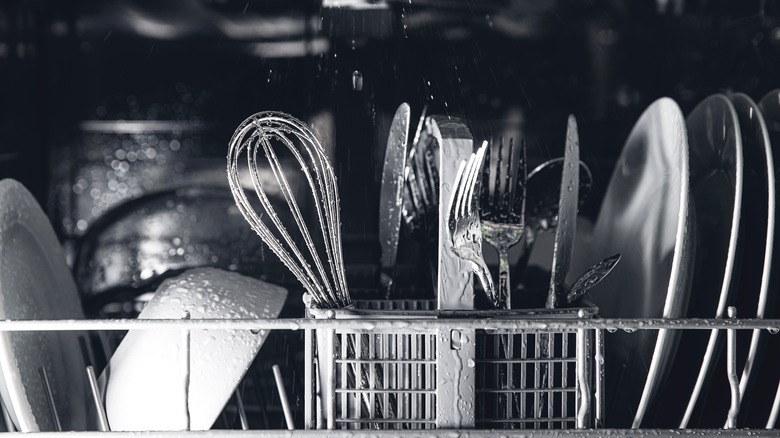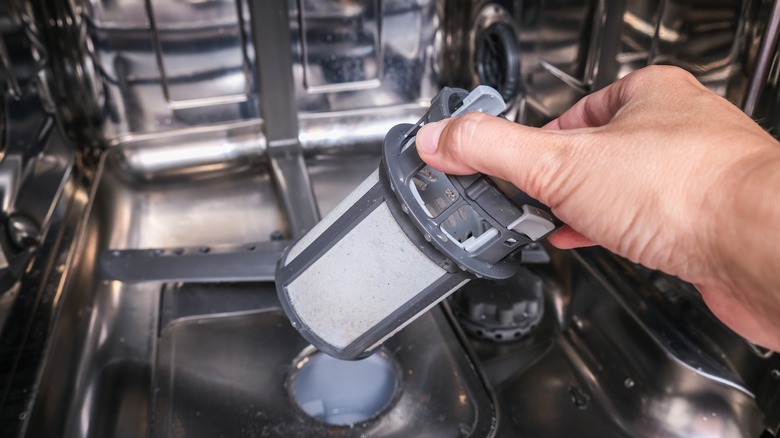Actually, It Does Matter How You Load Utensils In The Dishwasher
If your home is like most, chances are you have an ongoing debate with your partner or housemate about the right way to load the dishwasher. You may think whatever works, and that's true, though when it comes to loading your utensils, there are a few things most experts agree on. So, yes, the way you load your dishwasher matters.
Let's start with the silverware basket and rack. If you have a basket, load spoons and forks with the handle facing down so the dishwasher can more thoroughly spray them the hot water and detergent, as recommended by Whirlpool and Consumer Reports. This method is disputed, as an AJ Madison appliance expert told Martha Stewart that they recommend loading cutlery into the dishwasher with the handles up so you only need to touch the handles when putting them away.
Still, we think we'll err on the side of pointing cutlery handles down to ensure it's thoroughly washed per the manufacturers' instructions, but we'll make sure to use clean hands and reach into the cutlery basket to grab our silverware by the handles when unloading them. You'll have to decide for yourself which method to use with forks and spoons, but when washing knives, always load them with their handles facing up so you don't accidentally grab the blade when unloading.
Beyond the handle-up-versus-handle-down debate, there are a few things the experts agree on. When placing utensils in the basket, be sure to mix them up. Spooning is delightful with someone you love, but when your cutlery does it in the dishwasher, it may come out as dirty as when it went in. To keep them from cuddling together, alternate your spoons, forks, and knives, and slip them into premade holes if your cutlery basket has built-in separators. Finally, make sure the cutlery is dishwasher safe.
Other dishwasher loading tips
Hopefully, that settled that age-old argument about how to load cutlery in your dishwasher, in the interest of peace, you may be interested in learning more about the rest of it. The best technique may be specific to the make and model of your dishwasher. If it is newer than ten years, you don't need to pre-rinse. Simply scrape excess food directly into your compost bin or trash and save the water.
Consumer Reports tested different ways of loading a dishwasher using matching sets baked on food. As a result, they recommend putting large items like serving bowls and plates in the bottom rack. Save the top for smaller items like glasses and mugs. Put dishwasher-safe plastic containers in the top rack if they fit to minimize the risk of melting. When placing items, be careful not to position bowls or pans in a way that blocks your dishwasher's jets or hoses.
Finally, don't overcrowd your dishwasher. According to Consumer Reports, that is one of the biggest mistakes people make. Fill it, but make sure there is room for the hot water and air to circulate and reach all surfaces. The American Cleaning Institute suggests angling each dish so the dirtiest part faces the dishwasher's jets. This usually means facing the center and downward for everything except utensils that are upright in a basket.
How you unload your dishwasher and what you do later also matters
Unload the larger dishes from the bottom of your dishwasher first. That way any little pools of water that collect on the bottom of your cups and glasses won't spill downward onto the lower racks. Unload your utensils next. Save the glasses and cups from your top rack until last. If they are still too wet, you could air dry them in a rack or towel dry them while putting them away.
In addition to correct loading, it's best to clean your dishwasher and filter every three to six months to ensure your utensils and plates get sparkly clean. All of the attention you pay to correctly load and unload could be undone if the appliance itself is harboring germs, debris, or mold.
When in doubt, check your appliance's owner's manual if your dishwasher has an unusual layout. However, the principles of not overcrowding and not blocking the machine's water streams remain. While there isn't one singular way to load a dishwasher, the way you load it matters for hygiene as well as ease.


